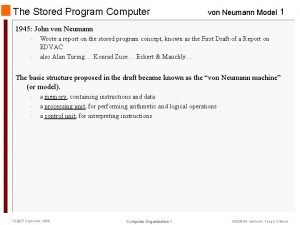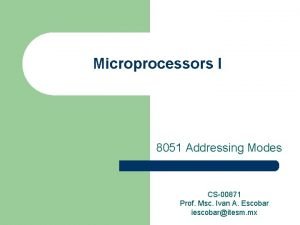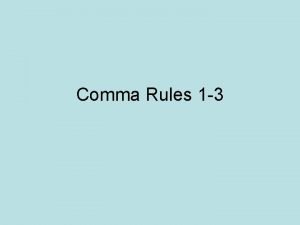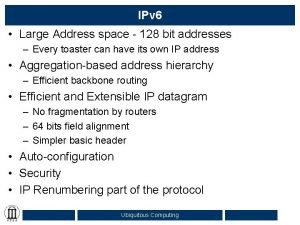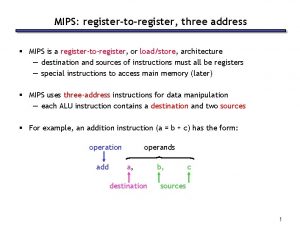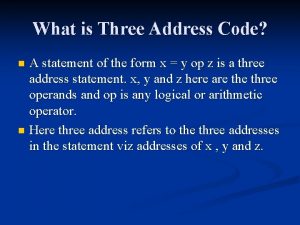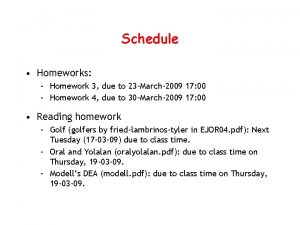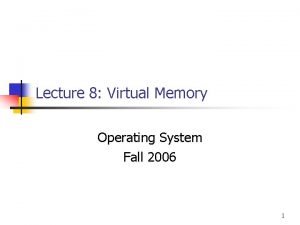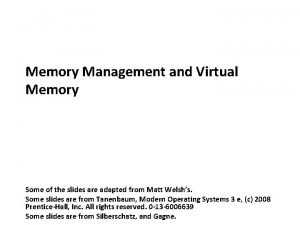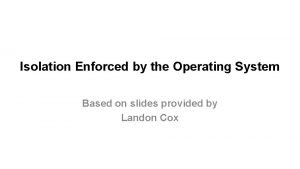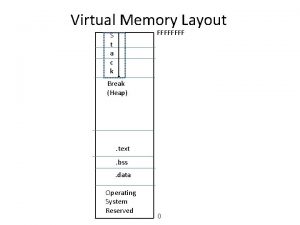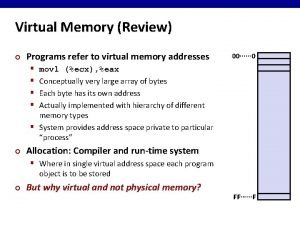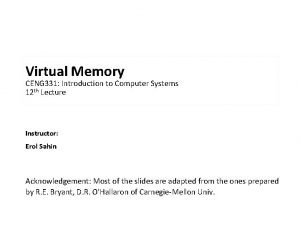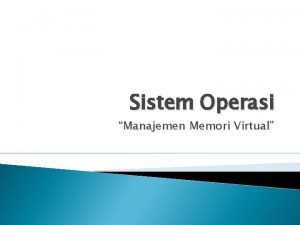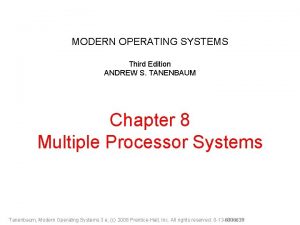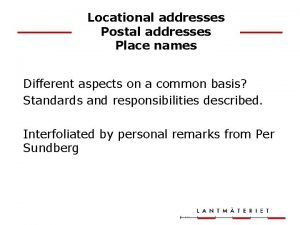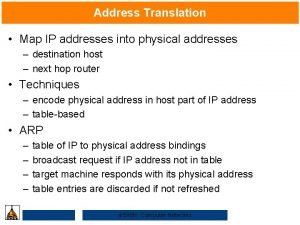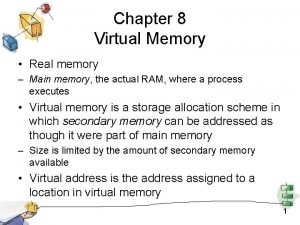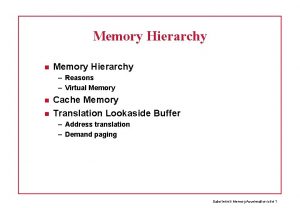Virtual Memory Names Virtual Addresses Physical Addresses Source



























































- Slides: 59

Virtual Memory

Names, Virtual Addresses & Physical Addresses Source Program Absolute Module Executable Image Name Space Pi’s Virtual Address Space Physical Address Space Yt: Virtual Address Space Physical Address Space

Locality Address Space for pi <1% 15% 35% 20% <1% 30% Execution time • Address space is logically partitioned – Text, data, stack – Initialization, main, error handle • Different parts have different reference patterns: Initialization code (used once) Code for 1 Code for 2 Code for 3 Code for error 1 Code for error 2 Code for error 3 Data & stack

Virtual Memory Secondary Memory Physical Address Space 0 Virtual Address Space for pi Virtual Address Space for pj Virtual Address Space for pk • Complete virtual address space is stored in secondary memory • Each address space is fragmented • Fragments of the virtual address space are dynamically loaded into primary memory at any given time n-1 Primary Memory

Virtual Memory • Every process has code and data locality – Code tends to execute in a few fragments at one time – Tend to reference same set of data structures • Dynamically load/unload currently-used address space fragments as the process executes • Uses dynamic address relocation/binding – Generalization of base-limit registers – Physical address corresponding to a compiletime address is not bound until run time

Virtual Memory (cont) • Since binding changes with time, use a dynamic virtual address map, Yt Virtual Address Space Yt

Address Formation • Translation system creates an address space, but its address are virtual instead of physical • A virtual address, x: – Is mapped to physical address y = Yt(x) if x is loaded at physical address y – Is mapped to W if x is not loaded • The map, Yt, changes as the process executes -- it is “time varying” • Yt: Virtual Address Physical Address {W}

Size of Blocks of Memory • Virtual memory system transfers “blocks” of the address space to/from primary memory • Fixed size blocks: System-defined pages are moved back and forth between primary and secondary memory • Variable size blocks: Programmer-defined segments – corresponding to logical fragments – are the unit of movement • Paging is the commercially dominant form of virtual memory today

Paging • A page is a fixed size, 2 h, block of virtual addresses • A page frame is a fixed size, 2 h, block of physical memory (the same size as a page) • When a virtual address, x, in page i is referenced by the CPU – If page i is loaded at page frame j, the virtual address is relocated to page frame j – If page is not loaded, the OS interrupts the process and loads the page into a page frame

Addresses • Suppose there are G= 2 g 2 h=2 g+h virtual addresses and H=2 j+h physical addresses assigned to a process – Each page/page frame is 2 h addresses – There are 2 g pages in the virtual address space – 2 j page frames are allocated to the process – Rather than map individual addresses • Yt maps the 2 g pages to the 2 j page frames • That is, page_framej = Yt(pagei) • Address k in pagei corresponds to address k in page_framej

Page-Based Address Translation • • Let N = {d 0, d 1, … dn-1} be the pages Let M = {b 0, b 1, …, bm-1} be page frames Virtual address, i, satisfies 0 i<G= 2 g+h Physical address, k = U 2 h+V (0 V<G= 2 h ) – U is page frame number – V is the line number within the page – Yt: [0: G-1] <U, V> {W} – Since every page is size c=2 h • page number = U = i/c • line number = V = i mod c

Address Translation (cont) Virtual Address g bits h bits Page # Line # “page table” Missing Page Yt j bits Physical Address Frame # h bits Line # CPU Memory MAR

Demand Paging Algorithm 1. 2. 3. 4. Page fault occurs Process with missing page is interrupted Memory manager locates the missing page Page frame is unloaded (replacement policy) 5. Page is loaded in the vacated page frame 6. Page table is updated 7. Process is restarted

Modeling Page Behavior • Let w = r 1, r 2, r 3, …, ri, … be a page reference stream – ri is the ith page # referenced by the process – The subscript is the virtual time for the process • Given a page frame allocation of m, the memory state at time t, St(m), is set of pages loaded – St(m) = St-1(m) Xt - Yt • Xt is the set of fetched pages at time t • Yt is the set of replaced pages at time t

More on Demand Paging • If rt was loaded at time t-1, St(m) = St-1(m) • If rt was not loaded at time t-1 and there were empty page frames – St(m) = St-1(m) {rt} • If rt was not loaded at time t-1 and there were no empty page frames – St(m) = St-1(m) {rt} - {y} • The alternative is prefetch paging

Static Allocation, Demand Paging • Number of page frames is static over the life of the process • Fetch policy is demand • Since St(m) = St-1(m) {rt} - {y}, the replacement policy must choose y -- which uniquely identifies the paging policy

Random Replacement • Replaced page, y, is chosen from the m loaded page frames with probability 1/m Let page reference stream, v = 203120316457 Frame 2 0 3 1 0 2 2 1 0 0 1 2 3 3 2 2 1 3 0 2 1 0 3 3 1 0 1 3 1 0 2 3 1 2 0 0 1 2 3 0 3 2 1 0 3 2 6 0 6 2 4 4 6 2 5 4 5 2 7 7 5 2 13 page faults • No knowledge of v not perform well • Easy to implement

Belady’s Optimal Algorithm • Replace page with maximal forward distance: yt = max xe. S t-1(m)FWDt(x) Let page reference stream, v = 203120316457 Frame 2 0 3 1 6 4 5 7 0 2 2 2 1 0 0 2 3

Belady’s Optimal Algorithm • Replace page with maximal forward distance: yt = max xe. S t-1(m)FWDt(x) Let page reference stream, v = 203120316457 Frame 2 0 3 1 6 4 5 7 0 2 2 2 1 0 0 2 3 FWD 4(2) = 1 FWD 4(0) = 2 FWD 4(3) = 3

Belady’s Optimal Algorithm • Replace page with maximal forward distance: yt = max xe. S t-1(m)FWDt(x) Let page reference stream, v = 203120316457 Frame 2 0 3 1 6 4 5 7 0 2 2 1 0 0 0 2 3 1 FWD 4(2) = 1 FWD 4(0) = 2 FWD 4(3) = 3

Belady’s Optimal Algorithm • Replace page with maximal forward distance: yt = max xe. S t-1(m)FWDt(x) Let page reference stream, v = 203120316457 Frame 2 0 3 1 0 2 2 1 0 0 0 2 3 1 2 2 0 1 0 3 1 2 0 3 1 6 4 5 7 2 0 1

Belady’s Optimal Algorithm • Replace page with maximal forward distance: yt = max xe. S t-1(m)FWDt(x) Let page reference stream, v = 203120316457 Frame 2 0 3 1 0 2 2 1 0 0 0 2 3 1 2 2 0 1 0 2 0 1 3 1 2 0 3 1 6 4 5 7 2 3 1 FWD 7(2) = 2 FWD 7(0) = 3 FWD 7(1) = 1

Belady’s Optimal Algorithm • Replace page with maximal forward distance: yt = max xe. S t-1(m)FWDt(x) Let page reference stream, v = 203120316457 Frame 2 0 3 1 0 2 2 1 0 0 0 2 3 1 2 2 0 1 0 2 0 1 3 2 3 1 1 2 3 1 FWD 10(2) = FWD 10(3) = 2 FWD 10(1) = 3 2 2 3 1 0 3 1 6 4 5 7 0 3 1

Belady’s Optimal Algorithm • Replace page with maximal forward distance: yt = max xe. S t-1(m)FWDt(x) Let page reference stream, v = 203120316457 Frame 2 0 3 1 0 2 2 1 0 0 0 2 3 1 2 2 0 1 0 2 0 1 3 2 3 1 1 2 3 1 FWD 13(0) = FWD 13(3) = FWD 13(1) = 2 2 3 1 0 0 3 1 3 0 3 1 1 6 4 5 7 0 3 1

Belady’s Optimal Algorithm • Replace page with maximal forward distance: yt = max xe. S t-1(m)FWDt(x) Let page reference stream, v = 203120316457 Frame 2 0 3 1 0 2 2 1 0 0 0 2 3 1 2 2 0 1 0 2 0 1 3 2 3 1 1 2 3 1 2 2 3 1 0 0 3 1 3 0 3 1 1 0 3 1 6 4 5 7 0 4 4 4 6 6 6 7 1 1 5 5 10 page faults • Perfect knowledge of v perfect performance • Impossible to implement

Least Recently Used (LRU) • Replace page with maximal forward distance: yt = max xe. S t-1(m)BKWDt(x) Let page reference stream, v = 203120316457 Frame 2 0 3 1 6 4 5 7 0 2 2 2 1 0 0 2 3 BKWD 4(2) = 3 BKWD 4(0) = 2 BKWD 4(3) = 1

Least Recently Used (LRU) • Replace page with maximal forward distance: yt = max xe. S t-1(m)BKWDt(x) Let page reference stream, v = 203120316457 Frame 2 0 3 1 6 4 5 7 0 2 2 2 1 1 0 0 0 2 3 3 BKWD 4(2) = 3 BKWD 4(0) = 2 BKWD 4(3) = 1

Least Recently Used (LRU) • Replace page with maximal forward distance: yt = max xe. S t-1(m)BKWDt(x) Let page reference stream, v = 203120316457 Frame 2 0 3 1 0 2 2 2 1 1 0 0 0 2 3 3 2 0 3 1 6 4 5 7 1 2 3 BKWD 5(1) = 1 BKWD 5(0) = 3 BKWD 5(3) = 2

Least Recently Used (LRU) • Replace page with maximal forward distance: yt = max xe. S t-1(m)BKWDt(x) Let page reference stream, v = 203120316457 Frame 2 0 3 1 0 2 2 2 1 1 0 0 0 2 3 3 2 1 2 3 0 3 1 2 0 3 1 6 4 5 7 1 2 0 BKWD 6(1) = 2 BKWD 6(2) = 1 BKWD 6(3) = 3

Least Recently Used (LRU) • Replace page with maximal forward distance: yt = max xe. S t-1(m)BKWDt(x) Let page reference stream, v = 203120316457 Frame 2 0 3 1 0 2 2 2 1 1 0 0 0 2 3 3 2 1 2 3 0 1 2 0 3 3 2 0 1 2 0 3 1 6 4 5 7 3 3 0 0 0 6 6 6 7 1 1 1 3 3 3 4 4 4 0 2 2 2 1 1 1 5 5

Least Recently Used (LRU) • Replace page with maximal forward distance: yt = max xe. S t-1(m)BKWDt(x) Let page reference stream, v = 203120316457 Frame 2 0 3 1 2 0 2 2 2 1 0 0 2 3 3 1 1 0 2 0 3 1 3 2 0 3 1 1 3 0 3 1 2 2 0 3 1 0 2 0 3 1 3 2 0 3 1 1 2 0 3 1 6 6 0 3 1 4 6 4 3 1 5 6 4 5 1 7 6 4 5 7 • Backward distance is a good predictor of forward distance -- locality

Least Frequently Used (LFU) • Replace page with minimum use: yt = min xe. S t-1(m)FREQ(x) Let page reference stream, v = 203120316457 Frame 2 0 3 1 6 4 5 7 0 2 2 2 1 0 0 2 3 FREQ 4(2) = 1 FREQ 4(0) = 1 FREQ 4(3) = 1

Least Frequently Used (LFU) • Replace page with minimum use: yt = min xe. S t-1(m)FREQ(x) Let page reference stream, v = 203120316457 Frame 2 0 3 1 6 4 5 7 0 2 2 1 0 0 1 2 3 3 FREQ 4(2) = 1 FREQ 4(0) = 1 FREQ 4(3) = 1

Least Frequently Used (LFU) • Replace page with minimum use: yt = min xe. S t-1(m)FREQ(x) Let page reference stream, v = 203120316457 Frame 2 0 3 1 0 2 2 1 0 0 1 2 3 3 2 2 1 3 0 3 1 2 0 3 1 6 4 5 7 2 1 0 FREQ 6(2) = 2 FREQ 6(1) = 1 FREQ 6(3) = 1

Least Frequently Used (LFU) • Replace page with minimum use: yt = min xe. S t-1(m)FREQ(x) Let page reference stream, v = 203120316457 Frame 2 0 3 1 0 2 2 1 0 0 1 2 3 3 2 2 1 3 0 3 1 2 0 3 1 6 4 5 7 2 1 0 FREQ 7(2) = ? FREQ 7(1) = ? FREQ 7(0) = ?

First In First Out (FIFO) • Replace page that has been in memory the longest: yt = max xe. S t-1(m)AGE(x) Let page reference stream, v = 203120316457 Frame 2 0 3 1 6 4 5 7 0 2 2 2 1 1 0 0 0 2 3 3

First In First Out (FIFO) • Replace page that has been in memory the longest: yt = max xe. S t-1(m)AGE(x) Let page reference stream, v = 203120316457 Frame 2 0 3 1 6 4 5 7 0 2 2 2 1 0 0 2 3 AGE 4(2) = 3 AGE 4(0) = 2 AGE 4(3) = 1

First In First Out (FIFO) • Replace page that has been in memory the longest: yt = max xe. S t-1(m)AGE(x) Let page reference stream, v = 203120316457 Frame 2 0 3 1 6 4 5 7 0 2 2 2 1 1 0 0 0 2 3 3 AGE 4(2) = 3 AGE 4(0) = 2 AGE 4(3) = 1

First In First Out (FIFO) • Replace page that has been in memory the longest: yt = max xe. S t-1(m)AGE(x) Let page reference stream, v = 203120316457 Frame 2 0 3 1 6 4 5 7 0 2 2 2 1 1 0 0 0 2 3 3 AGE 5(1) = ? AGE 5(0) = ? AGE 5(3) = ?

Belady’s Anomaly Let page reference stream, v = 012301401234 Frame 0 1 2 3 0 0 3 1 1 2 2 2 0 3 0 2 1 3 0 1 4 4 0 1 0 4 0 1 1 4 0 1 2 4 2 1 3 4 2 3 4 4 2 3 Frame 0 1 2 3 0 0 0 0 1 1 1 2 2 3 3 3 1 0 1 2 3 4 4 1 2 3 0 4 0 2 3 1 4 0 1 3 2 4 0 1 2 3 3 0 1 2 4 3 4 1 2 • FIFO with m = 3 has 9 faults • FIFO with m = 4 has 10 faults

Stack Algorithms • Some algorithms are well-behaved • Inclusion Property: Pages loaded at time t with m is also loaded at time t with m+1 LRU Frame 0 1 2 3 0 1 4 0 1 2 3 4 0 0 3 1 1 2 2 2 Frame 0 1 2 3 0 1 4 0 1 2 3 4 0 0 0 1 1 2 2 2 3 3

Stack Algorithms • Some algorithms are well-behaved • Inclusion Property: Pages loaded at time t with m is also loaded at time t with m+1 LRU Frame 0 1 2 3 0 0 3 1 1 2 2 2 0 1 4 0 1 2 3 4 3 1 0 Frame 0 1 2 3 0 1 4 0 1 2 3 4 0 0 0 1 1 1 2 2 3 3 3

Stack Algorithms • Some algorithms are well-behaved • Inclusion Property: Pages loaded at time t with m is also loaded at time t with m+1 LRU Frame 0 1 2 3 0 0 3 1 1 2 2 2 0 3 0 2 1 4 0 1 2 3 4 3 0 1 Frame 0 1 2 3 0 0 0 0 1 1 1 2 2 3 3 3 1 4 0 1 2 3

Stack Algorithms • Some algorithms are well-behaved • Inclusion Property: Pages loaded at time t with m is also loaded at time t with m+1 LRU Frame 0 1 2 3 0 0 3 1 1 2 2 2 0 3 0 2 1 3 0 1 4 0 1 2 3 4 4 0 1 Frame 0 1 2 3 0 0 0 0 1 1 1 2 2 3 3 3 1 0 1 2 3 4 0 1 4 3

Stack Algorithms • Some algorithms are well-behaved • Inclusion Property: Pages loaded at time t with m is also loaded at time t with m+1 LRU Frame 0 1 2 3 0 0 3 1 1 2 2 2 0 3 0 2 1 3 0 1 4 4 0 1 0 4 0 1 1 4 0 1 2 2 0 1 3 2 3 1 4 2 3 4 Frame 0 1 2 3 0 0 0 0 1 1 1 2 2 3 3 3 1 0 1 2 3 4 0 1 4 3 0 0 1 4 3 1 0 1 4 3 2 0 1 4 2 3 0 1 3 2 4 4 1 3 2

Stack Algorithms • Some algorithms are well-behaved • Inclusion Property: Pages loaded at time t with m is also loaded at time t with m+1 FIFO Frame 0 1 2 3 0 0 3 1 1 2 2 2 0 3 0 2 1 3 0 1 4 4 0 1 0 4 0 1 1 4 0 1 2 4 2 1 3 4 2 3 4 4 2 3 Frame 0 1 2 3 0 0 0 0 1 1 1 2 2 3 3 3 1 0 1 2 3 4 4 1 2 3 0 4 0 2 3 1 4 0 1 3 2 4 0 1 2 3 3 0 1 2 4 3 4 1 2

Implementation • LRU has become preferred algorithm • Difficult to implement – Must record when each page was referenced – Difficult to do in hardware • Approximate LRU with a reference bit – Periodically reset – Set for a page when it is referenced • Dirty bit

Dynamic Paging Algorithms • The amount of physical memory -- the number of page frames -- varies as the process executes • How much memory should be allocated? – Fault rate must be “tolerable” – Will change according to the phase of process • Need to define a placement & replacement policy • Contemporary models based on working set

Working Set • Intuitively, the working set is the set of pages in the process’s locality – Somewhat imprecise – Time varying – Given k processes in memory, let mi(t) be # of pages frames allocated to pi at time t • • mi(0) = 0 i=1 k mi(t) |primary memory| Also have St(mi(t)) = St(mi(t-1)) Xt - Yt Or, more simply S(mi(t)) = S(mi(t-1)) Xt - Yt

Placed/Replaced Pages • S(mi(t)) = S(mi(t-1)) Xt - Yt • For the missing page – Allocate a new page frame – Xt = {rt} in the new page frame • How should Yt be defined? • Consider a parameter, , called the window size – Determine BKWDt(y) for every y S(mi(t-1)) – if BKWDt(y) , unload y and deallocate frame – if BKWDt(y) < do not disturb y

Working Set Principle • Process pi should only be loaded and active if it can be allocated enough page frames to hold its entire working set • The size of the working set is estimated using – Unfortunately, a “good” value of depends on the size of the locality – Empirically this works with a fixed

Example ( = 3) Frame 0 1 2 3 4 5 6 7 0 0 # 1

Example ( = 4) Frame 0 1 2 3 4 5 6 7 0 0 # 1

Implementing the Working Set • Global LRU will behave similarly to a working set algorithm – Page fault • Add a page frame to one process • Take away a page frame from another process – Use LRU implementation idea • Reference bit for every page frame • Cleared periodically, set with each reference • Change allocation of some page frame with a clear reference bit – Clock algorithms use this technique by searching for cleared ref bits in a circular fashion

Segmentation • Unit of memory movement is: – Variably sized – Defined by the programmer • Two component addresses, <Seg#, offset> • Address translation is more complex than paging • Yt: segments x offsets Physical Address {W} • Yt(i, j) = k

Segment Address Translation • Yt: segments x offsets physical address {W} • Yt(i, j) = k • s: segments segment addresses • Yt(s(seg. Name), j) = k • l: offset names offset addresses • Yt(s(seg. Name), l(offset. Name)) = k • Read implementation in Section 12. 5. 2

Address Translation <segment. Name, offset. Name> s segment # l offset ? Limit Yt Relocation Missing segment + Limit Base P To Memory Address Register

Implementation • Segmentation requires special hardware – Segment descriptor support – Segment base registers (segment, code, stack) – Translation hardware • Some of translation can be static – No dynamic offset name binding – Limited protection

Multics • • Old, but still state-of-the-art segmentation Uses linkage segments to support sharing Uses dynamic offset name binding Requires sophisticated memory management unit • See pp 368 -371
 Memory locations and addresses in computer organization
Memory locations and addresses in computer organization Page fault
Page fault Virtual memory in memory hierarchy consists of
Virtual memory in memory hierarchy consists of Physical memory vs logical memory
Physical memory vs logical memory Episodic vs semantic memory
Episodic vs semantic memory Excplicit memory
Excplicit memory Long term memory vs short term memory
Long term memory vs short term memory Internal memory and external memory
Internal memory and external memory Primary memory and secondary memory
Primary memory and secondary memory Which memory is the actual working memory?
Which memory is the actual working memory? Eidetic memory vs iconic memory
Eidetic memory vs iconic memory Shared memory vs distributed memory
Shared memory vs distributed memory Misattribution of memory example
Misattribution of memory example Are we running out of ip addresses
Are we running out of ip addresses Qapi at a glance
Qapi at a glance Official letter with three addresses
Official letter with three addresses 8051 addressing modes
8051 addressing modes Classful ip addressing
Classful ip addressing Comma after address
Comma after address Reserved address
Reserved address 128 bit address space
128 bit address space Datelines ap style
Datelines ap style Utkarsh jaiswal
Utkarsh jaiswal Mips instruction format
Mips instruction format Three address code examples
Three address code examples (acv-s03) homework - addresses and references
(acv-s03) homework - addresses and references What is virtual memory
What is virtual memory Virtual memory management techniques
Virtual memory management techniques Virtual memory in operating system
Virtual memory in operating system Virtual memory in operating system
Virtual memory in operating system Virtual memory advantages
Virtual memory advantages Explain virtual memory in computer architecture
Explain virtual memory in computer architecture Demand paging in virtual memory
Demand paging in virtual memory Virtual memory in os
Virtual memory in os Process virtual address space
Process virtual address space Virtual memory os
Virtual memory os Virtual memory
Virtual memory Virtual memory segmentation
Virtual memory segmentation Memory hierarchy
Memory hierarchy Virtual memory os
Virtual memory os Virtual memory os
Virtual memory os Virtual memory is commonly implemented by
Virtual memory is commonly implemented by Slab is one or more physically contiguous frames.
Slab is one or more physically contiguous frames. Virtual memory os
Virtual memory os Process virtual address space
Process virtual address space Kai hierarchy
Kai hierarchy Tlb
Tlb Stack memory layout
Stack memory layout Apa karakteristik dari memori virtual
Apa karakteristik dari memori virtual Csce 430
Csce 430 Virtual memory
Virtual memory Reddit tifu dataset
Reddit tifu dataset Virtual memory
Virtual memory Virtual memory
Virtual memory Virtual memory
Virtual memory Virtual memory
Virtual memory G mail
G mail Karakteristik dari memori virtual
Karakteristik dari memori virtual Implementasi virtual memory
Implementasi virtual memory Shared virtual memory
Shared virtual memory
